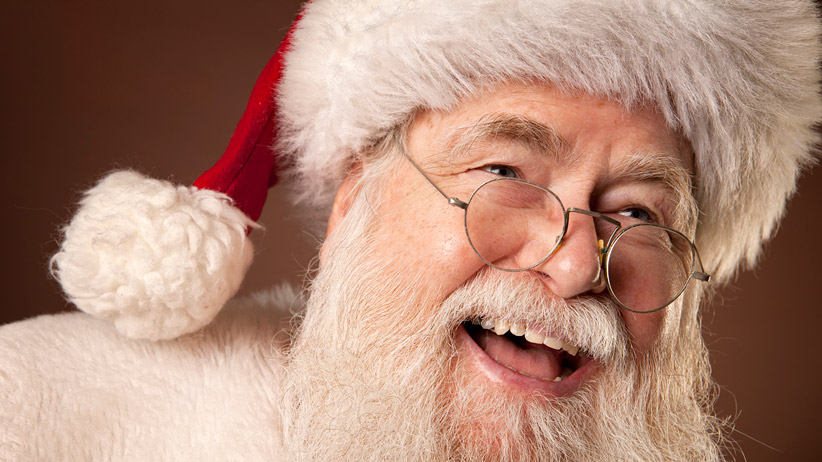Meet the pilot who flies with Santa Claus
NORAD pilots escort Santa Claus on Christmas Eve, helping if he drops his presents or runs into bad weather. Tonight, Captain Pierre-David Boivin gets his turn.
Santa Claus Dieter Spears/Getty Images
Share

Pierre-David Boivin remembers well the Christmas when he was five years old. Woken late on Christmas Eve by his parents, Boivin and his younger brother toddled sleepily to the back door. “He just arrived,” their parents told them. Could they see him? The boys peered through the back window into the darkness, searching for the sleigh their parents said they’d seen gliding through the sky.
And there he was: Santa Claus, emerging from the woods behind their Quebec home, hauling presents for the brothers and their cousins.
Now 27, Boivin is a captain in the Royal Canadian Air Force, based in Bagotville, Que., and one of this year’s NORAD Santa Claus escorts. Pilots meet up with Santa throughout Christmas Eve, a trek kids can follow on the NORAD website. The tradition began in 1955 when a Colorado Springs Sears ad misprinted a phone number for children to call for updates on Santa’s progress. Instead, they reached the predecessor to the North American Aerospace Defense Command, the Continental Air Defense Command. Staff gamely checked their radar for the children calling in, adding pilot escorts and online tracking over the years.
Maclean’s spoke to Boivin the day before the flight, which will be his first with Santa. The interview has been edited and condensed.
Q: What are you most looking forward to about flying with Santa Claus?
A: Well, seeing Santa flying his sleigh is actually something that I really want to see. Because I’d seen Santa when I was a kid, when he was giving gifts at my home, but flying with him in formation, I’ve never done it. So I’m pretty privileged. I’m really excited.
Q: Is there a special formation?
A: Not really, just regular formation. I’m just going to follow my lead [pilot] because I’m just the wingman. The lead [Capt. Andrew Jakubaitis] is going to fly intercept and I’m probably going to roll out on [Santa Claus’s] right wing, the lead’s going to be on his left wing. We’re going to look at him, wiggle our wings … He’s got to slow down for us because he’s very, very fast and he’s just going to [let] us intercept, for us to say hi, and that’s it.
Q: How did you get this job?
A: They were asking for volunteers and I just gave my name. They generally need two pilots each year volunteering to fly during Christmas. And I was going to stay around anyway because I’m from Bagotville, so I gave my name and they picked me.
Q: How long does it take to do the flight?
A: It varies. About an hour and a half to two hours. So you’ve just taken off, it takes 45 minutes to reach Santa Claus and the way back will be about 45 minutes as well. We’ll fly with him for about 10, 15 [minutes], so about that. An hour and a half to two hours.
[Cold Lake, Alta.-based pilots Lieut.-Col. William Radiff and U.S. Marine Corps Lieut.-Col. Mark Bortnem take over from there.]
Santa is doing the whole world in 24 hours. He starts at midnight in Japan, and when it’s midnight in Japan, it’s probably 12 hours earlier here in Quebec. So he gets to do all of Asia, Europe, Africa, then he goes back to the North Pole and as soon as he’s back to the North Pole, he’s filling his sleigh again with the North America gifts. Then he goes through Quebec, [the rest of Canada] and the United States.
Q: What’s the point of the intercept?
A: It’s to help him if he’s got any issues. If he drops any gifts by accident, we’re going to send search and rescue to get them. If he’s got bad visibility, or he’s got problems, we’re going to try to help him, but it has never happened in 60 years.
Q: What is Santa like? What does he say when you talk to him?
A: We cannot talk with him because he doesn’t have radios, but we communicate with hand signals. So as soon as we roll out on his wing, we just say hi so we can see him properly. He says hi as well. What he likes is when we wiggle our wings and we break off of his sleigh. It’s a nice manoeuvre he can see from his sleigh.
Q: What time will you fly with him?
A: Generally it’s between 9 p.m. and midnight, depending. He has to wait [to take off] until all the kids are asleep and that generally turns out to be between nine and midnight.